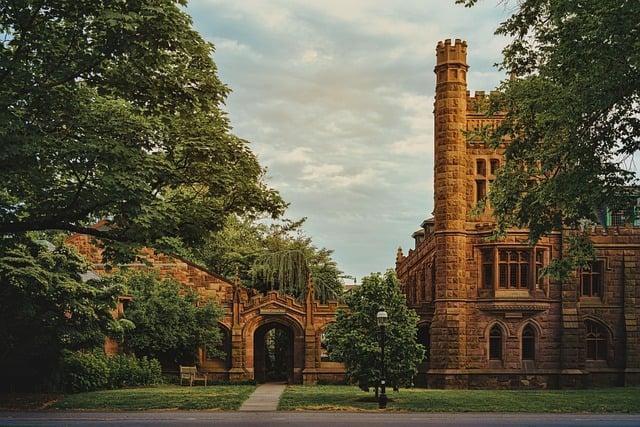Italian immigration to the U.S. began in the mid-19th century, driven by economic opportunities and political turmoil, with early settlers contributing significantly through labor and entrepreneurship. A larger influx occurred at the turn of the 20th century, attracted by industrial jobs. Notable Italian Americans like Mario Cuomo have left indelible marks on U.S. history and culture. The Italian-American Flag symbolizes their vibrant heritage, enriching American society in culinary arts, literature, film, music, and storytelling. Today, cultural events, educational initiatives, and the flag preserve this heritage, fostering a sense of belonging and pride while acknowledging their integral role in shaping America's identity.
“Unveiling the vibrant tapestry of Italian-American contributions, this article explores the rich history and enduring legacy of immigrants from Italy in the United States. From their initial waves in the 19th century to modern-day achievements, Italian Americans have left an indelible mark on the nation’s cultural, culinary, and artistic landscapes.
We delve into the past, highlighting significant immigration periods and the challenges faced. Notable figures and their stories inspire, while the vibrant Italian-American flag symbolizes unity and pride. Today, preserving this heritage is a testament to their enduring impact.”
- The History of Italian Immigration to the United States
- Notable Italian-American Figures and Their Impact
- Italian-American Contributions to Food, Culture, and Art
- Preserving and Honoring the Italian-American Heritage Today
The History of Italian Immigration to the United States

Italian immigration to the United States has a rich and complex history dating back to the mid-19th century. During this period, economic opportunities and political instability in Italy drove many to seek a better life across the Atlantic. The first significant wave of Italian immigrants arrived in the U.S. during the 1850s, primarily settling in urban areas like New York City and Philadelphia. These early settlers often faced discrimination and harsh working conditions, but they contributed immensely to the country’s growth through their labor and entrepreneurship.
Over time, Italian immigration continued to flourish, with another large influx occurring at the turn of the 20th century. Many Italians were attracted by the promise of industrial jobs, particularly in the Northeast and Midwest regions. They brought with them a vibrant culture, culinary traditions, and a strong sense of community that enriched American society. Today, Italian Americans proudly wave the Italian-American Flag to honor their ancestral heritage and celebrate their significant contributions to the United States.
Notable Italian-American Figures and Their Impact

Notable Italian-Americans have left an indelible mark on U.S. history and culture, proudly waving the Italian American Flag as a symbol of their achievements. Figures like Mario Cuomo, a prominent business leader and politician known for his relentless drive and influence in New York state, exemplify the entrepreneurial spirit that has defined many Italian-American communities. His career spanned various sectors, from real estate to politics, leaving a lasting impact on infrastructure development.
Similarly, artists such as Leonardo da Vinci, although born in Renaissance Italy, are celebrated for their profound influence on American art and science. Their innovations and creations have not only inspired generations but also contributed to the nation’s cultural heritage. This rich legacy of artistic and intellectual prowess continues to shape and color the vibrant tapestry of Italian-American contributions to U.S. society.
Italian-American Contributions to Food, Culture, and Art

The Italian-American community has significantly enriched the cultural fabric and culinary landscape of the United States. Their contributions to food are a testament to their vibrant heritage, bringing dishes like pasta, pizza, and gelato into the mainstream American diet. These culinary staples have evolved and adapted over time, reflecting the diversity and creativity of Italian-American chefs and home cooks alike. The Italian-American Flag, a symbol of pride and unity, often represents the fusion of traditional Italian flavors with local American ingredients, creating unique and beloved dishes that celebrate both heritages.
Beyond cuisine, Italian-Americans have left their mark on various artistic fields. Their influence in literature, film, and visual arts is profound, with many notable authors, filmmakers, and artists carrying Italian heritage. This cultural impact extends to music as well, where Italian-American musicians have contributed to genres like opera, jazz, and pop, enriching the country’s musical tapestry. The Italian-American community has also fostered a rich tradition of storytelling, preserving historical narratives and folklore that offer valuable insights into their experience in the U.S.
Preserving and Honoring the Italian-American Heritage Today

In the modern age, preserving and honoring Italian-American heritage involves a vibrant display of culture and community. The iconic Italian American Flag serves as a powerful symbol, representing the diverse and rich contributions of this demographic to U.S. society. Through annual festivals, parades, and cultural events, communities across the nation come together to celebrate their roots, passing down traditions from one generation to the next. This collective effort ensures that the Italian-American story remains alive, fostering a sense of belonging and pride among its descendants.
Educational initiatives play a pivotal role in honoring this heritage. Schools, museums, and cultural centers organize programs that highlight the achievements of Italian Americans in various fields, from arts and literature to politics and science. By integrating these narratives into the broader American story, it becomes possible to recognize the integral part played by Italian immigrants and their descendants in shaping the country’s identity and character.
